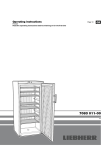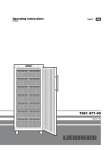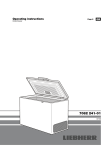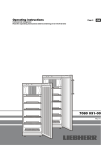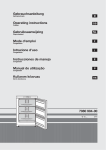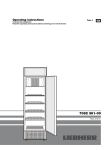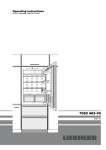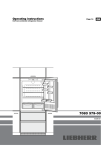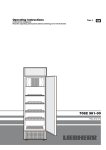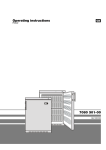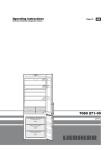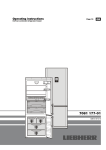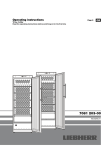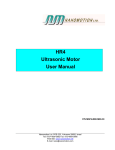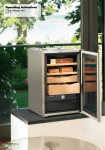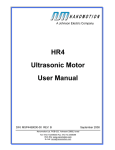Download Operating instructions
Transcript
Operating instructions
Freezer
Read the operating instructions before switching on for the first time
Page 6
GB
7081 479-00
G 52 912
Disposal notes
The appliance contains some reusable materials
and should be disposed of properly - not simply with
unsorted household refuse. Appliances which are no
longer needed must be disposed of in a professional
and appropriate way, in accordance with the current
local regulations and laws.
When disposing of the appliance, ensure that the refrigeration circuit
is not damaged to prevent uncontrolled escape of the refrigerant
it contains (data on type plate) and oil.
• Disable the appliance.
• Pull out the plug.
• Cut through the connecting cable.
Safety instructions and warnings
• To prevent injury or damage to the unit, the appliance should be
unpacked and set up by two people.
• In the event that the appliance is damaged on delivery, contact
the supplier immediately before connecting to the mains.
• To guarantee safe operation, ensure that the appliance is set up
and connected as described in these operating instructions.
• Disconnect the appliance from the mains if any fault occurs. Pull
out the plug, switch off or remove the fuse.
• When disconnecting the appliance, pull on the plug, not on the
cable.
WARNING
Danger of suffocation due to packing material and plastic film!
Do not allow children to play with packing material. Take the packaging material to an official collecting point.
Range of appliance use
The appliance is suitable solely for cooling food in a domestic
environment or similar. This includes use in, for example
- in staff kitchenettes, bed and breakfast establishments,
- by guests in country homes, hotels, motels and other forms of
accommodation,
- in catering and similar services in the wholesale trade.
Use the appliance solely as is customary within a domestic environment. All other types of use are inadmissible. The appliance
is not suitable for storing and cooling medicines, blood plasma,
laboratory preparations or similar substances and products
covered by the 2007/47/EC Medical Devices Directive. Misuse of
the appliance can result in the stored products suffering harm or
perishing. Furthermore, the appliance is not suitable for operation
in potentially explosive atmospheres.
• Any repairs and work on the appliance should only be carried
out by the customer service department, as unauthorised work
could prove highly dangerous for the user. The same applies to
changing the mains power cable.
• Do not allow naked flames or ignition sources to enter the appliance. When transporting and cleaning the appliance ensure that
the refrigerant circuit is not damaged. In the event of damage,
make sure that there are no ignition sources nearby and keep the
room well ventilated.
• Do not stand on the plinth, drawers or doors or use them to support anything else.
• This appliance is not intended for use by persons (including children) with reduced physical, sensory or mental capabilities or lack
of experience and knowledge unless they have been given initial
supervision or instruction concerning use of the appliance by a
person responsible for their safety. Children should be supervised
to ensure that they do not play with the appliance.
• Avoid prolonged skin contact with cold surfaces or chilled/frozen
food. This could cause pain, numbness and frostbite. In the case
of prolonged skin contact, protective measures should be taken,
e.g. gloves should be worn.
• Do not eat ice cream, particulary ice lollies or ice cubes, immediately after taking them from the freezer compartment as there
is a risk of "burning" because of the very cold temperatures.
• Do not consume food which has been stored for too long, as it
could cause food poisoning.
Description of the appliance
Operating elements
Type plate
• The appliance is designed for freezing and storing food and for
making ice and is intended for domestic use. If used for commercial
purposes, the relevant legal regulations applicable to the trade
concerned must be observed.
• Do not store explosives or sprays using combustible propellants
such as butane, propane, pentane etc. in the appliance. Electrical
components might cause leaking gas to ignite. You may identify
such sprays by the printed contents or a flame symbol.
• Do not use electrical appliances inside the appliance.
Drawers
Adjustable height feet
6
• The appliance is designed for use in enclosed areas. Do not
operate the appliance outdoors or in areas where it is exposed
to splash water or damp conditions.
Climate rating
The climate rating indicates the room temperature at which the appliance may be
operated in order to achieve full refrigeration
performance.
Operating and control elements
GB
The climate rating is indicated on the type
plate.
The position of the type plate is shown in
the section entitled Description of the appliance.
Climate rating
SN
N
ST
T
SN-ST
SN-T
Room temperature
+10°C to +32°C
+16°C to +32°C
+16°C to +38°C
+16°C to +43°C
+10°C to +38°C
+10°C to +43°C
Do not operate the appliance outside the specified room
temperature range.
Setting up
• Do not place appliance in areas of direct sunlight or next to a
stove, heater or similar object.
• The floor on which the appliance stands should be horizontal and
level.Compensate for uneven floors with the adjustable feet.
• Always ensure good ventilation. Do not cover ventilation openings
or grille.
• Do not place heat-emitting appliances, e.g. microwave oven,
toaster, etc., on top of the freezer.
• Standard EN 378 specifies that the room in which you install your
appliance must have a volume of 1 m3 per 8 g of R 600a refrigerant
used in the appliance, so as to avoid the formation of inflammable
gas/air mixtures in the room where the appliance is located in the
event of a leak in the refrigerant circuit. The quantity of refrigerant
used in your appliance is indicated on the type plate on the inside
of the appliance.
• Always install the appliance directly against the wall.
Dimensions
A= 1725 mm
B= 750 mm
C= 760 mm
D= 1447 mm
E= 790 mm
1 Temperature display
2 Temperature buttons
3 On/Off button
4 SuperFrost button
5 Audible warning on/off button
6 Child-proof lock
Switching the appliance on and off
Switching on: Press the ON / OFF button so that the
temperature display lights up/flashes. When the appliance
is switched on for the first time and while it is still warm,
the display will contain dashes until the temperature falls
below 0°C.
Switching off: Press the ON / OFF button for approx. two seconds
so that the temperature display goes out.
Setting the temperature
To increase the temperature
Press the Up button.
To reduce the temperature
Press the Down button.
- When pressing one of the buttons for the first time, the display
will start to flash.
- Pressing this button again enables you to change the temperature
setting.
- The electronic controls will switch over automatically about 5 seconds after the last time you pressed the button, and the actual
temperature will be displayed.
- The temperature can be set at between -14°C and -28°C.
If F 3 appears in the display, the appliance has a fault. Consult the
customer service department indicating the fault number displayed.
Saving energy
Electrical connection
Only operate the appliance with alternating current (AC).
The permissible voltage and frequency are indicated on the type
plate. The position of the type plate is shown in the section entitled
Description of the appliance.
The socket must be properly earthed and protected by a fuse.
The tripping current of the fuse must be between 10 A and 16 A.
The socket must not be situated behind the appliance and must
be easily accessible.
Do not connect the appliance using an extension cable or extension socket.
- Always ensure good ventilation. Do not cover ventilation openings
or grille.
- Do not place appliance in areas of direct sunlight or next to a
stove, heater or similar object.
- The energy consumption depends on the installation conditions,
e.g. the ambient temperature.
- Keep the time the appliance is open to a minimum.
- Store food logically.
- Ensure that all food is well packed and covered for storage. This
will prevent frost from forming.
- First cool warm food to room temperature before storing it.
- If there is a thick layer of frost in the appliance: defrost the appliance.
Accumulated dust increases the energy consumption:
- Once a year, dust the refrigerating unit together with the metal
grille of the heat exchanger at the back of the appliance.
Do not use stand-alone inverters (conversion
of direct current to alternating current/threephase current) or energy-saving plugs. Risk
of damage to the electronic control system!
7
Power failure "frost-control" display
If nA appears in the display, this means that the
freezer temperature has risen too high during the
last few hours or days due to a power failure.
If you press the ALARM button whilst the display
is reading nA, the highest temperature registered
during the power failure will be displayed. Check
the quality of the food and its suitability for consumption in case it
has become too warm or even defrosted.
The highest temperature will appear for appox. 1 minute. After that,
the actual temperature in the freezer will re-appear. The display
can be switched off by repeatedly pressing the ALARM button.
Audible warning signal
Audible door alarm:
This sounds when the door has been left open for longer
than about 60 seconds. Press the audible warning on/off
button to cancel the alarm. The alarm switches back to
standby when the door is shut.
Audible/visual temperature alarm:
It sounds when it is not cold enough in the freezer compartment.
The temperature display will also flash;
The audible warning device is switched off by pressing the ALARM
button. The temperature display will continue to flash until the cause
of the alarm has been rectified.
This can be caused by:
• the freezer door being left open for a long time, allowing warm
ambient air to enter;
• a long power failure;
• a fault in the appliance.
In each case, make sure food has not defrosted or perished.
Additional functions
In set-up mode you can set the child-proof lock and adjust the
brightness of the display.
Activating set-up mode:
• Press SuperFrost button for approx. 5 secs - the SuperFrost button
flashes - the display shows c for child-proof lock.
Note: the value to be altered flashes.
• Select the required function by pressing the Up/Down button:
c = child-proof lock, h = brightness of the display
• Now select/acknowledge function by pressing SuperFrost button
briefly:
> For c = child-proof lock,
press the Up/Down button to select
c1 = child-proof lock on or
c0 = child-proof lock off and acknowledge with
the SuperFrost button.
When the symbol
activated.
is lit, the child-proof lock is
>For h = brightness, press Up/Down button to
select
h1= minimum to
h5 = maximum brightness and acknowledge with
SuperFrost button.
Exit set-up mode:
• Exit the set-up mode by pressing the On/Off button; after 2 min.
the electronic system switches over automatically. The normal
operating mode is activated again.
8
Freezing
Fresh food should be frozen to the core as rapidly as possible.
Frozen food can also be given a cold boost. This is provided by
the "Superfrost" facility.
The maximum amount of food wich can
be frozen in 24 hours is shown on the
type plate ("Freezing capacity ...kg/24
hours"). This amount varies according
to the model and climate rating.
Freezing with Superfrost
Press the Superfrost button briefly so that the LED lights
up.
• For small amounts of frozen food, it is normally sufficient
to switch on Superfrost 6 hours beforehand. For the maximum
amount (see freezing capacity on the type plate) you will need to
switch it on 24 hours beforehand.
• Then place the fresh food inside the freezer.
Note: The bottom two drawers are not suitable for freezing fresh
food. Only pre-frozen food can be stored there.
- The Superfrost function switches off automatically. Depending
on the quantity of food placed in the freezer, this will normally be
between 30 and max. 65 hours.
You should not switch on the Superfrost function:
- when placing frozen food in the freezer;
- when freezing up to approx. 2 kg fresh food daily.
Notes on freezing
• Always store identical food items together.
• Pack food which you are freezing yourself in quantities appropriate
to your household. To ensure that the food freezes right through,
the following quantities should not be exeeded per package: fruit,
vegetables: up to 1 kg, meat: up to 2,5 kg.
• Pack frozen food in standard freezer bags or reuseable plastic,
metal or aluminium containers.
• Do not allow fresh food which is to be frozen to come into contact
with food already frozen. Always keep packs dry in order to avoid
them sticking together.
• Always write the date and contents on the pack and do not exeed
the stated storage time for the food.
• Do not freeze bottles and cans which contain carbonated drinks
as they might burst.
• Only take out as much food as is immediately required for thawing.
Use food which has been thawed in prepared meals as quickly
as possible.
Frozen food can be thawed in the following ways:
–in a fan oven
–in a microwave oven
–at room temperature
–in the refrigerator: the cold given off by the frozen food is used for
cooling.
Defrosting
After a longer period of operation a layer of frost or ice can build up
on the cooling plates in the freezer compartment. This will increase
the energy consumption of the freezer. The cooling plates should
therefor be defrosted regularly.
• Switch the appliance off to defrost. Pull out the mains plug.
• Remove the drawers.
• Wrap the frozen food in paper or blankets and store in a cool place.
• To speed up the defrosting process put a saucepan of hot but not
boiling water on one of the cooling elements.
• Leave the door of the appliance open while defrosting. After
defrosting mop up the remaining water and clean the appliance.
Do not use any mechanical devices or other artificial aids for
defrosting other than those recommended by the manufacturer.
Cleaning
GB
Changing over door hinges
• Remove cover
.
• Unscrew hinge bracket
. Remove the door.
• Transfer cover plate
to the opposite side.
• Transfer hinge components
on the hinge bracket
to the
opposite side.
• Lever out pressure plates
at the front and slide away.
• Transfer door handles
and plugs
to the other side.
• Attach pressure plates
.
• Transfer plug
.
• Remove covers
and
.
• Transfer pin
to the opposite side.
• Re-attach covers
and
on the opposite side.
• Suspend door on hinge pin
and close.
• Insert hinge bracket
in lower door mounting and screw into
place.
• Click cover
into place.
1
2
4
3
5
6
5
8
bl bm
9
bl bm
9
2
1
2
7
Before cleaning always switch off the appliance. Pull out the
mains plug or remove/unscrew the fuse.
Clean the inside, equipment parts and outer walls with lukewarm
water and a little detergent. Do not use abrasive or acid cleaners
or chemical solvents.
Do not use steam cleaners because of the risk of injury and
damage.
• Ensure that no cleaning water penetrates into the electrical components or ventilation grille.
• Dry all parts well with a cloth.
• The dust should be removed from the refrigeration unit and heat
exchanger – metal grid at the back of the appliance – once a year.
• Do not damage or remove the type plate on the inside of the appliance. It is very important for servicing purposes.
Malfunctions
You may be able to rectify the following faults by checking
the possible causes yourself:
• Appliance does not function: the control lamps are not lit.
–Is the appliance switched on?
–Is the plug correctly fitted in the mains socket?
–Is the socket fuse intact?
• Loud running noise:
–Is the appliance set up firmly on the floor?
–Does the appliance cause nearby items of furniture or objects to
vibrate? Please note that noises caused by the refrigerant circuit
cannot be avoided.
• The temperature is not low enough:
–Is the temperature setting correct (see "Setting the temperature")?
–Have excessive amounts of fresh food been placed in the appliance?
– Does the separately installed thermometer show the correct reading?
– Is the ventilation system working properly?
– Is the appliance set up too close to a heat source?
Shutting your appliance down
If your appliance is to be shut down for any length of time, switch it
off and disconnect the plug or remove the fuse. Clean the appliance
and leave the door open in order to prevent unpleasant smells.
The appliance complies with the relevant safety regulations and
EC directives 2004/108/EC and 2006/95/EC.
All types and models are subject to continuous improvement and
the manufacturer therefore reserves the right to make modifica
tions to the shape, equipment and technology.
If none of the above causes
apply and you cannot rectify
the fault yourself, contact the
nearest customer service department stating the type of
appliance ➊, service number
➋ and appliance number ➌ as
indicated on the type plate.
9





